Amongst my other vices, I dabble in board game design. A few of my designs were available from Nestorgames for a while; most are now out of print. Some are listed on BGG (see my designer page), and still others are buried deep in Ai Ai.
You have permission to create copies of any of my games for your own personal use. Computer implementations are also welcome, as long as they are free to play.
Here is a quick introduction to my games...
Of the many games I have designed, these are my favourites.
| Image |
About |
Notes |
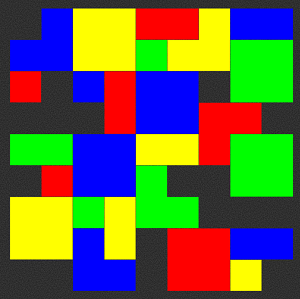 |
Four (2012)
The Game Crafter rules (includes strategy tips)
Nestorgames (OOP) rules
EN
JP
BGG Entry
Video review on the excellent VemKaJogar youtube channel
Ai Ai report
Play in Ai Ai
Play on Tabletop Simulator
Limited edition in glass by Alix Schwartz
Play at abstractplay.com (turn based)
|
BUY - acrylic set, UK seller.
BUY - wooden set, US seller.
A game inspired by the Four Colour Theorem in which four shapes in four colours are placed in a virtual grid according to four constraints.
Four won (along with Veletas) the BoardGameGeek Best Combinatorial 2-player Game of 2013 award.
Bonus fact: This is actually my third attempt to create a game based on the four colour theorem; Chroma (below) was attempt #2.
Attempt #1 was something like numberlink, where players attempted to make chains of each colour with certain constraints; it never worked as a game, sadly.
|
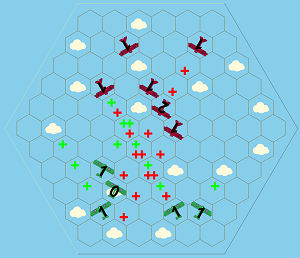 |
Crosshairs (2010)
Engish Rules Medals
BGG Entry
Ai Ai report
Play in Ai Ai
Play on Tabletop Simulator
Vassal module
3D print & play
|
Out Of Print. Anybody interested in publishing Crosshairs, please drop me a line.
Crosshairs is a game of pure skill with a World War I aerial combat theme.
The central concept is simple; if two enemy planes are shooting at a plane, it is destroyed.
Add cloud cover, multiple planes per side and the possibility of complex manoeuvering, and you have a pure strategy aerial combat game of considerable depth.
Crosshairs was a finalist in the BoardGameGeek Best Combinatorial 2-player Game of 2011/2012 awards.
"Manages to be sufficiently evocative of dogfighting (with planes, not with dogs) that you can forget you're playing a combinatorial abstract strategy game. The learning curve is good, it plays quickly, and (thanks in part to the clouds) it has excellent replayability." - getareaction, BGG
"I was looking for a simple aerial combat game, found Wings of War too fiddly, and then saw this: how can such a simple idea work so well? The playing modes for 3-4 players are a welcome bonus!" - franchi, BGG
Bonus fact: Back when I designed the game, I ran a competition over on BGG to come up with the name of the game. The funniest suggestion was Camel Fokkers.
|
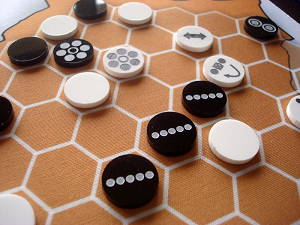 |
Sleepers
Nestorgames (OOP) rules
EN
DE
FR
JP
Play in Ai Ai
BGG Entry
|
Out Of Print. Anybody interested in publishing Sleepers, please drop me a line.
Sleepers balances bluff and strategy to create an intense 30-minute battle. There are multiple goals, all of which are viable win conditions.
Sleepers started life as a hex variant where players either (a) put down two tiles (face-down), one belonging to each player; or (b) flipped a face-down tile, taking another turn if it was their colour. Sadly, that didn't work too well; but it sat in the back of my mind, and eventually became the backbone of the game once the theme came along. This is a shoulders-of-giants game; once I had the basic mechanics down pat, I looked at a lot of other games for inspiration when choosing powers and goals that combo well together (honorable mentions include Magic: the Gathering (morphing in particular), Samurai, and Mentalis). The biggest challenge was squeezing the tiles down to a set that allowed lots of combos, yet still made all goals attainable.
On the subject of theme, we (I?) tend to think of the French Resistance as a single organization, but it wasn't anything like that. There were many revolutionary groups, each with different goals and motivations. You can read more here.
"A delightful little game. Interesting spatial combos, bluff, spatial competition. All of that in a short playing time (and in a very portable package). Highly recommended." - trapeeze, BGG
"I loved this game the first time I played and more I play, the better it gets." - lizlam, BGG
"An abstract with theme! Who knew? Great game with a lot of nerve wracking choices. Tons of replayability!" - TedW, BGG
|
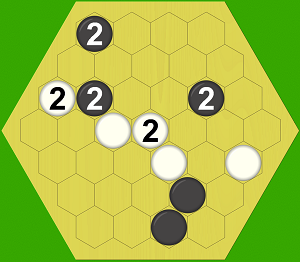 |
Furl (2020)
Nestorgames (OOP) rules
EN
JP
BGG Entry
Ai Ai report (Hex)
Ai Ai report (Square)
Play in Ai Ai
Play at abstractplay.com (turn based)
|
Out Of Print. Anybody interested in publishing Furl, please drop me a line.
Furl is a race game, with unusual movement. Each turn, a player either furls(gathers up a row of their pieces into a stack), or unfurls (sows the pieces in a straight line), possibly capturing in the last space. In this sense, you can think of it as a mancala variant, but I think of it as a tentacle rising up and crashing down.
Furl placed 2= in the BGG 2020 Combinatorial awards. (Tumbleweed won, deservedly; the other runners up were Mattock and Trike.)
"Wow! This game! A new grid movement mechanic! I mean, we've seen a similar mechanic before where stacks of pieces move as far as they are tall before, but I really love the simplicity of either furling or unfurling. Coupled with the goal of a single stone on your opponent’s starting line at the beginning of YOUR turn really makes for some fun puzzles as you try to make sure you can capture-back even if you can’t stop your opponent’s advance. I was very surprised by how much I loved this one, and it ended up being my pick for best game." Martin Grider (BGG forums)
|
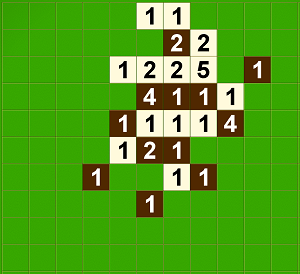 |
Knight Line (2013)
Nestorgames (OOP) rules
EN
JP
BGG Entry
Ai Ai report
Play in Ai Ai
|
Out Of Print. Anybody interested in publishing Knight Line, please drop me a line.
A boardless stacking game, based around knight moves; a deep game with minimalist equipment.
Knight Line won 4th place in the BoardGameGeek Best Combinatorial 2-player Game of 2013 award
|
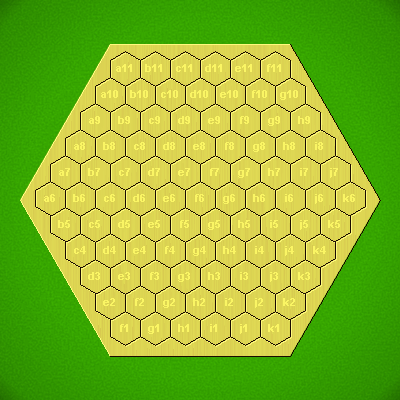 |
Flipping (2025)
Ai Ai report
Play in Ai Ai
|
Can be played with a pile of coins in two colours, or other reversible tokens. Assuming coins, I'll call the players Silver and Copper.
Each turn, starting with Silver, place a coin in an empty space with Heads showing; then flip all adjacent coins to their opposite sides.
If, at the end of your turn, you have four of your pieces in a straight line showing the same side (all heads or all tails), then you win. If the board is full and no one has won then the game is a draw.
To offset any first player advantage, play with the following swap rule.
|
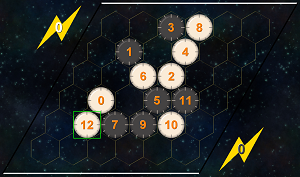 |
Paradox Hex (2021)
Play in Ai Ai
|
This is a hex variant, but the same concept can be applied to many games where pieces are placed but never move.
Paradox Hex builds on the same mechanism I used in Tavener's Time Travel Tic Tac Toe, buried somewhere down below.
Instead of a standard piece, players take turns adding a numbered piece to the board; the number counts up from 0,
and can be thought of as the tick of the clock on which the piece was added.
By using temporal energy, players can then go back in time and move the pieces.
A simple shift to an unoccupied space costs 1 energy and keeps the turn (it was always there); for a higher cost, a piece with a low number can also move to a space with a higher numbered piece;
because it hasn't been placed yet.
This latter move causes a paradox, resulting in the future piece - and all subsequent pieces - being removed. Play resumes from the last legal move.
|
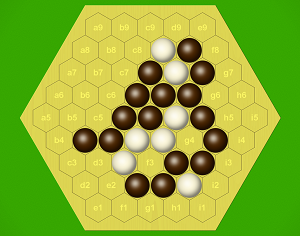 |
Coalesce (2022)
Play in Ai Ai
|
Coalesce is a simple unification game, inspired by this thread over on BGG. It is the sister game to Unify.
Components
1 Hexagonal board, size 5
36 Black pieces
30 White pieces
Contract phase
Player 1 places any number of black pieces on the board.
Player 2 chooses to play Coalesce (Black) or Divide (White).
Play
Players alternate playing stones, starting with Divide.
If Coalesce connects all their stones into a single group, they win.
If this becomes impossible, Divide wins.
|
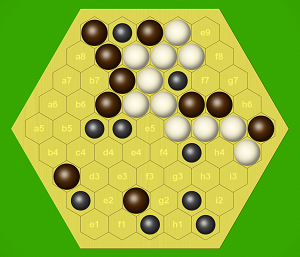 |
Unify (2022)
Play in Ai Ai
|
Unify is a simple unification game, inspired by this thread over on BGG. It is the sister game to Coalesce.
Components
1 Hexagonal board, size 5
30 Black pieces
30 White pieces
10 Pieces in a third, neutral colour
Contract phase
Player 1 places any number of neutral pieces on the board.
Player 2 chooses a role: Unify (Black) or Divide (White).
Play
Players alternate playing stones, starting with Divide.
If Unify connects all neutral stones, via stones of their colour, they win.
If unification becomes impossible, Divide wins.
|
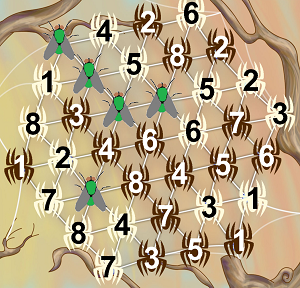 |
Web of Flies (2010)
Nestorgames (OOP) rules
EN
JP
BGG Entry
Ai Ai report - flies
Ai Ai report - Rocks
Play in Ai Ai
|
Out Of Print. Anybody interested in publishing Web of Flies, please drop me a line.
The first iteration of this game was a card game called Box of Spiders, which I designed for a card game competition.
(BoF was, itself, inspired by a magazine article on commercial uses of spider silk, which pointed out that if you start with a box of spiders, it isn't long before you end up with a box containing one big, mean looking spider. But I digress.)
The game was fun, with a feel similar to DVONN, but the endgame was somewhat lacking. After the competition, I played the game a few more times, and realised that it would work better on a hexagonal grid, and thus Web of Flies was born.
|
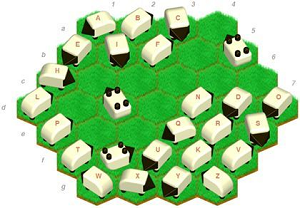 |
Mutton (2009)
Nestorgames (OOP) rules
EN
DE
FR
JP
BGG Entry
Video review on the excellent VemKaJogar youtube channel
Play in Ai Ai
Play on boardspace.net
Play on pbmserv
Android (play store)
Cameron's Mutton page
Review by Tom Vasel
3D print files (these have been uploaded without permission but while the game is out of print, no harm is being done; grab 'em while you can).
|
Out Of Print. Anybody interested in publishing Mutton, please drop me a line.
In collaboration with Cameron Browne.
I designed this game primarily for Rosie, my wife. She likes sheep, and mastermind; which is what got me thinking about the initial design. I was also playing a lot of Texas hold-'em at the time, so I wanted to combine the deduction element with the ability to bluff.
Anyhow, the initial design had the farmer moving the sheep, and felt rather flat - the sheep got split up as much as possible, and didn't feel very sheeplike at all; this also made the farmer's job far to easy. Sheepishly, I put the game aside, until Cameron Browne came along... he designed the graphics, and even found the lego sheep design used in the prototypes; with his help, I found the missing element - obvious in retrospect - the wolf moves the sheep. With this simple change, the sheep tend to huddle together, and the farmer has to work much harder to identify the wolves.
I love the way that the theme works; the wolves seem to prowl around the edge of the flock, while the sheep huddle in nervous bunches. The farmer gets more and more nervous, until he suddenly goes berserk. Lots of tension, and a nice mix of deduction and bluff.
No problem if you don't like it - I didn't design it for you ;)
|
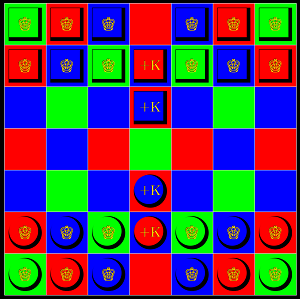 |
CheAOsS (2011)
BGG Entry
Play in Ai Ai
Vassal module (created by Alfonso Velasco)
|
Chaos Chess. In this chaotic game, a piece's movement is determined by a combination of (a) its colour, and (b) the colour of the square it is standing on. A large number of possible pieces means that no two games will be the same. The Ai Ai implementation is combinatorial, but the rules as written start with the piece powers unknown, and force the players to explore.
CheAOsS has not been published, but all necessary files for Print & Play are available on BoardGameGeek.
|
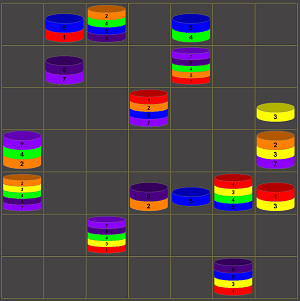 |
Low vs High (2018)
Ai Ai report
Play in Ai Ai
|
This started off as a game where the players were trying to assemble rainbows, either forwards or backwards.
This was very confusing, so I added numbers.
Then I realised that the colours weren't necessary, and the game wasn't limited to a 7x7 board.
That's the way game design goes sometimes; I left the colours in the Ai Ai implementation for sentimental reasons; but you could play with number or letter tiles if so inclined.
|
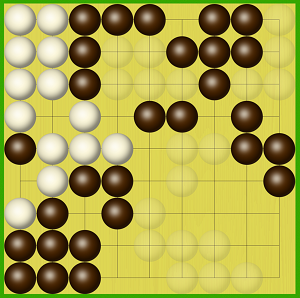 |
Itsy (2020)
Ai Ai report
Play in Ai Ai
|
Start with go, distill it down to its essence using the Symple protocol, and you have Itsy. The rules are very short:
A group is a maximal set of orthogonally adjacent pieces of a single colour. Groups can never merge.
Each turn, in order:
- Grow: Add a piece adjacent to each of your existing groups
- Spawn: Add a piece to the board, forming a new group.
If you cannot complete your turn (usually because a group is surrounded), you lose.
|
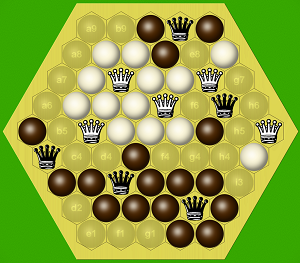 |
Simple Territory Game (2021)
Play in Ai Ai
|
Not sure where this one came from, but it's related to so many games that it's hard to believe it's not been done before. Nonetheless, I can't find an exact match.
Play
On the first turn, white makes one move; on each subsequent turn, take two moves (12* protocol).
Each move, select one of your pieces and move it in a straight line, over empty spaces only. At the end of your move, place a neutral piece in your starting space.If you have no legal moves (and only then), pass.
Goal
When both players pass in succession, the game ends. Players score according to the quantity of neutral pieces adjacent to their pieces. The player with the highest score wins.
|
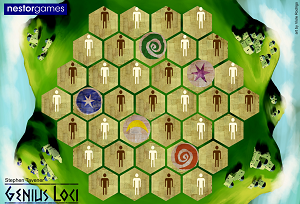 |
Genius Loci (2013)
BGG Entry
Ai Ai report
Play in Ai Ai |
Vassal module (created by Alfonso Velasco)
This game is inspired by the "Activator Piece" discussions in the BGG abstract games forums. This is the purest game I could devise - the men do not move at all, unless an activator allows them to do so; the theme of spirits demanding sacrifices came naturally from the mechanics. Plus, it seems I like killing stuff!
Genius Loci was a finalist in the BoardGameGeek Best Combinatorial 2-player Game of 2014 award
|
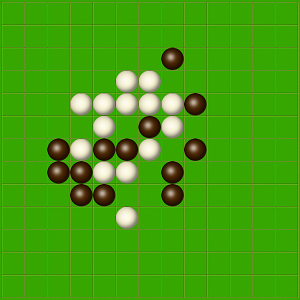 |
Knight Light (2020)
Ai Ai report
Play in Ai Ai
|
This is a reworking of Kight Line for a print and play collection, which ended up different enough to be its own game.
There are no stacks, movement follows the 12* protocol, and a line of 5 rather than 4 is required to win.
|
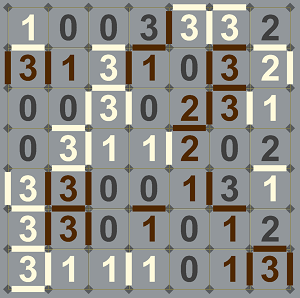 |
SLLUG (2020)
Ai Ai report
Play in Ai Ai
|
SLLUG is taken from the even more unwieldy "Slitherlink-like Game", Slitherlink being my favourite logic puzzle.
The game itself ended up a majority scoring game much closer to Libraria
than Slitherlink, but it is what it is!
|
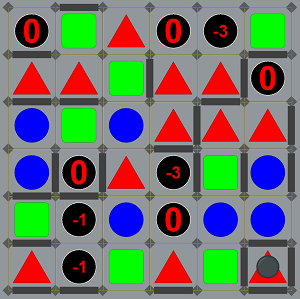 |
Dotty Boxes (2020)
Ai Ai report
Play in Ai Ai
|
Dotty Boxes is a fusion of Dots and Boxes and the collect-me scoring systems seen in modern eurogames. The opening phases will have similar strategy to dots and boxes, but as the game progresses you'll have to balance quantity against quality.
|
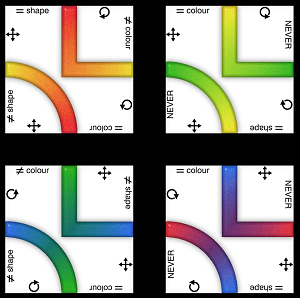 |
Actiles (2009)
BGG Entry
|
In collaboration with Cameron Browne.
Actiles stands for "Action tiles". This is a seemingly simple game played with just four tiles; but it will melt your brain.
The print&play files are available on the boardgamegeek page.
|
These games are generally lighter and fluffier than the games above, and considerations other than skill are likely to determine the winner.
| Image |
About |
Notes |
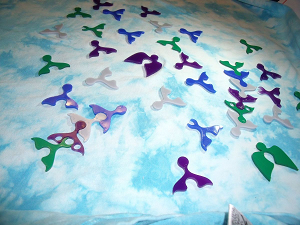 |
Swish (2010)
Nestorgames (OOP) rules
EN
JP
BGG
|
Out Of Print but Nestorgames may have some stock remaining. Anybody interested in publishing Swish, please drop me a line.
An collaboration with Cameron Browne.
A continuous space strategy game for 2-4 players; fish parts designed by Cameron Browne.
|
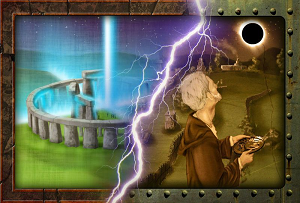 |
Time Gradient (2009)
BGG Entry
|
A simple card game with strategic bluffing and a strong time travel theme. There was almost a commercial version!
Time Gradient won this Traditional Card Games Design Contest over on BoardGameGeek.
It's also mentioned on Wikipedia
|
 |
The Easter Bunny Game (2010)
BGG Entry
|
This is a family pick-up and deliver game that I designed for the kids. The deliverables are Cadbury's Mini-Eggs.
All necessary files to play should be in the BGG files section (note: the board looks a bit weird on the BGG file section, but is fine when downloaded).
|
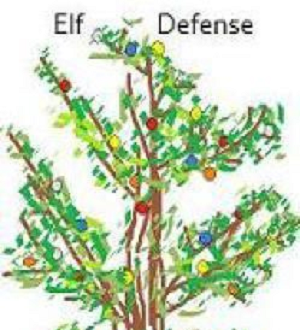 |
Elf Defense (2010)
BGG Entry
|
This is a tower defense Christmas themed game, which accommodates any number of players via a circle of death mechanism. It captures the true spirit of Christmas; greed. |
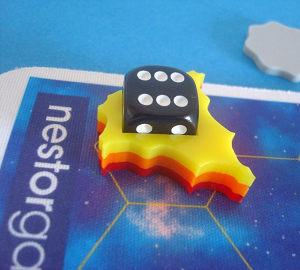 |
Rebel Moon Defense (2009)
Nestorgames (OOP) rules
EN
DE
FR
JP
BGG
Review by Tom Vasel
|
Out Of Print.
In collaboration with Cameron Browne.
This is a homage to many tower defense computer games. Admire the chaos bomb wrapped in Mandelbrot shields!
|
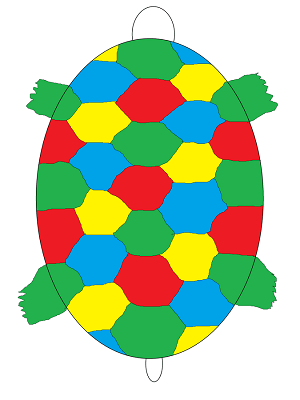 |
Turtle Thumb Tussle (2013)
BGG Entry
|
Manual dexterity game in the strictest sense; think twister for fingers! |
 |
Story Dice (2009)
BGG Entry
|
Roll the dice; tell a story using the results. There's a very similar commercial game, but I got there first! |
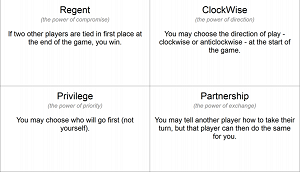 |
Cosmic Convention (2002)
BGG Entry
|
Long, long ago, Rosie and I got married, and instead of the traditional reception we had a games convention; Consummation.
We designed this metagame (inspired by Cosmic Encounter) for use at our wedding convention - small metapowers for use inside and outside of the games.
They also saw use in TowerCon in Blackpool, and perhaps some other places. |
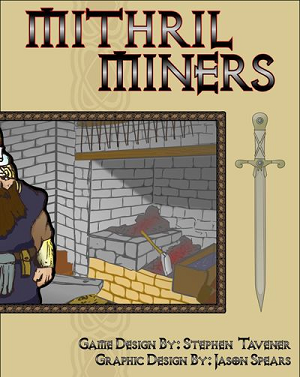 |
Mithril Miners (2009)
BGG Entry
|
Competition game. This is actually a mean and nasty game masquerading as a co-op! |
The following are variants of existing games; if these happen to be good, then the credit should probably go to the original designer, not me!
| Image |
About |
Notes |
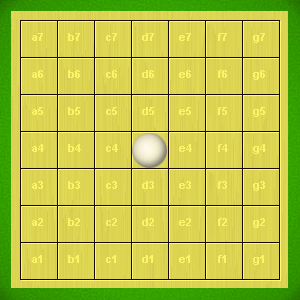 |
Gamma (2020)
Play in Ai Ai
|
This game was inspired by Delta (Erich Brunner) and Epsilon (Michael Howe).
Fire and Ice (Dale Walton) uses a similar add-an-opponent's piece mechanism but with different topology and movement.
Start with either a 7x7 square board or a size 5 hexhex board and a sufficient number of stones in two colours; player 1 starts with a piece in the centre of the board.
Each player turn consists of two moves, with each move as follows:
- Move a piece of your colour in a straight line, at least two spaces; the destination and any spaces crossed must be empty
- After moving, place a piece of the opponent's colour directly behind the piece you moved.
If you make a line of four, you win; unless you simultaneously make a line for the opponent; in this case, you lose. You also lose if you have no legal moves.
|
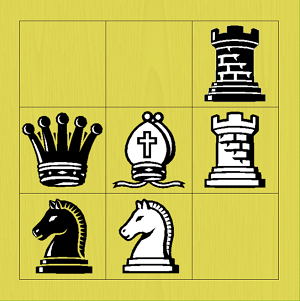 |
Chess Line (2020)
Play in Ai Ai
|
Round about 1984, a game called Tic Tac Chess by Michael Waitsman was published in Omni magazine.
It's interesting, but is a game of not losing; with perfect play, the game will never end.
I set out to change that; I modified the piece movement rules, added other pieces, and allowed asymmetric matchups.
There are now around 400 different combinations, many of them decisive and most of them balanced on a knife-edge.
Possibly the most interesting game you can play on a 3x3 board and lots of replay value!
|
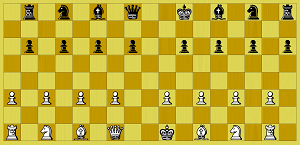 |
Isolation Chess (2020)
Play in Ai Ai
|
Chess for the modern age. |
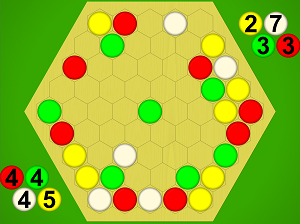 |
Leaping (2020)
Ai Ai report
Play in Ai Ai
|
This is my variation of H. J. R. Murray's variation of the Victorian game Leapfrog. It's considerably faster, with more nuanced scoring.
|
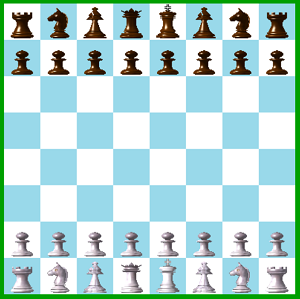 |
Quantum Chess (2000)
Listed in the Encyclopedia of Chess Variants
Play in Zillions of Games
Chess Variants Entry
|
"This is my costume. I'm a homicidal maniac. They look just like everyone else" — Wednesday Addams
This chess variant starts off normally, but goes crazy in the middle and endgame.
Standard chess rules, with the following change: Any unit that is not observed (attacked or defended) may move to any unobserved empty space.
|
 |
Hexi (2000)
Play in Zillions of Games
|
A hexagonal variant of Don Green's masterpiece, Octi. |
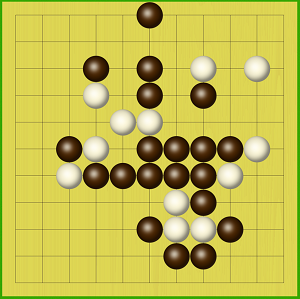 |
Unfair, Intercardinal family (2015)
BGG (Unfair)
BGG Entry (Intercardinal)
BGG Entry (Intercardinal X)
BGG (Intercardinal Yavalath)
Play in Ai Ai
|
Inspired by Gomoku (and in one case, Yavalath), these games all look at different ways of breaking symmetry.
Unfair: white must make a line of 4, black must make a line of 7. Orthogonal lines only.
Intercardinal: a line of 4 wins in the N/S axis, 5 in the E/W axis.
Intercardinal X: a line of 6 wins orthogonally, 5 diagonally.
Intercardinal Yavalath: a line of 4 orthogonally wins, but a line of 3 diagonally loses.
|
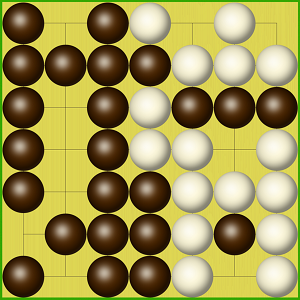 |
Magnetic Go (2017)
Play in Ai Ai
|
Like coloured pieces repel, unlike colours attract. |
Games with a strong core, that need a little something extra to make them tier 1 games.
| Image |
About |
Notes |
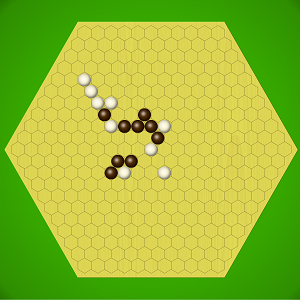 |
HexAlign (2020)
Ai Ai report
Play in Ai Ai
|
This game introduces the "pullover" mechanism, as Cameron Browne christened it. My intention was to create a boardless n-in-a-row game, but the lack of clarity is such that playing without a board would be almost impossible. What we actually have is a rather opaque game with similarities to both The Game of Life and PlusMinus. I've also tried a conneaction variant, which was similarly confusing... and considerably longer.
Play: On the first turn, play a hexagon of your colour; on each subsequent turn, play two hexagons according to the following rules:
- Place a pieces so it shares at least one edge with an existing hexagon,
- Perform all necessary hops.
Hopping: After placing a hexagon, if there is a line of pieces to one side of it and no piece on the other side, the farthest piece in line jumps to the empty space. Note that a move can produce up to three hops, each in a different direction.
Example. A player places a piece at B. There is an empty space to the right, and a row of pieces marked a to the left:
. . . a a a a B .
The leftmost piece in the line is moved to the empty space:
. . . . a a a B a
Goal: make a line of 5 to win.
|
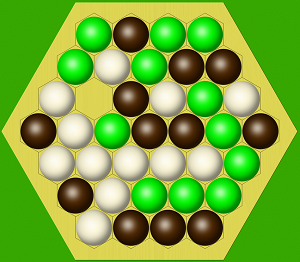 |
Underdog (2020)
Ai Ai report
Play in Ai Ai
|
This is an experimental 3-player game which tries to avoid kingmaking issues.
Each turn, move one of your pieces to a neighbouring space containing an enemy piece; that piece is captured. The turn now passes to the player with the fewest pieces; if there is a tie for fewest pieces, your turn continues.
When all players pass, each player calculates their score as follows: first, scores the number of pieces you have left on the board; then for each enemy, multiply by the number of pieces you have captured belonging to that enemy.
|
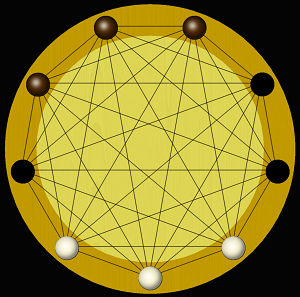 |
Claustrophobia (2020)
Ai Ai report
Play in Ai Ai
|
This is apparently a partisan arc geography game. Each path can only be traversed once, last to move wins;
the huge number of connections at the start of the game mean that the opening is completely opaque (to me at least),
though the AI seems to manage to find good moves.
|
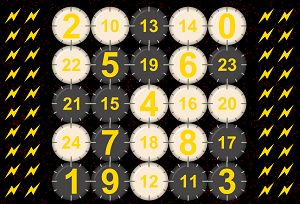 |
Tavener's Time Travel Tic Tac Toe (2018)
Play in Ai Ai
|
So, we all make mistakes; what if you could go back and move your piece to a better space? That's the idea behind this game. It is achieved by a simple operation that can be applied to any strict placement game - by transforming undifferentiated pieces into numbered piece, it becomes easy to see when a piece was placed, and therefore how expensive it is to move.
In its current form the game is flawed; but there is a unique idea in there just looking for the right game!
|
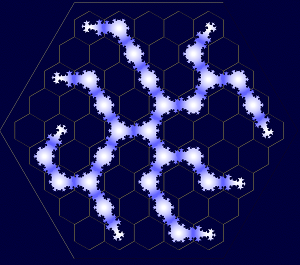 |
Snowpaque (2015)
Play in Ai Ai
Play in Ludii
|
Created 2015 for my Christmas Ai Ai release, this is a very simple impartial game that results in a design vaguely reminiscent of a snowflake.
The name is a fusion of snowflake and opaque - for the strategy is opaque indeed!
|
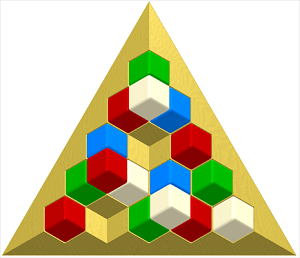 |
Chroma (2008)
BGG Entry
Play on Richard Rognlie's pbmserv
Cameron Browne's Chroma page
|
Based on the four colour theorem, and in collaboration with Cameron Browne; what makes this work is the fixed move order, which allows players to plan ahead and prevents this from being a cold game. Where it fails a little, is that the game can end quickly with much of the board unused.
|
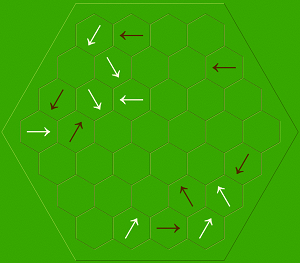 |
Arrows (2017)
Ai Ai report
Play in Ai Ai
|
An experiment with directional pieces. Each turn, place a piece so it points to at least one empty space; if it points towards a friendly piece, you lose. |
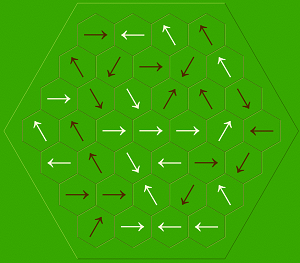 |
Arrows2 (2017)
Ai Ai report
Play in Ai Ai
|
An experiment with directional pieces. Each turn, rotate a piece or capture by moving in the direction you're pointing. A distant relative of Crosshairs. |
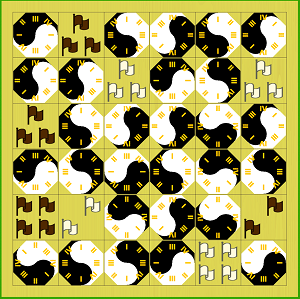 |
Merx (2016)
Play in Ai Ai
|
At this point, I have no idea how this game came to be! Pieces are impartial, but movement and capture isn't. Odds are, the AI can play this a lot better than you can. |
 |
XMas Lights (2017)
Play in Ai Ai
|
Another Christmas game, this one from 2017. It's pretty, but the moving xmas tree lights confuse mere mortals; the AI will crush you.
Still, I'm sure I'll be rewarded when the AIs take over.
|
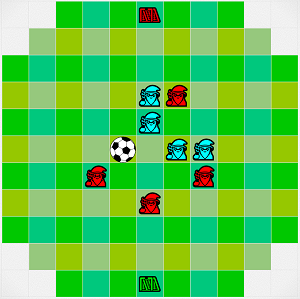 |
Wizball (2018)
Play in Ai Ai
|
An attempt to combine Phutball and Vault to create a dynamic goal scoring game with crazy combos. It has balance issues at the moment, though. |
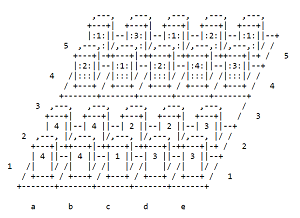 |
Curio
BGG Entry
Play on Richard Rognlie's pbmserv |
In collaboration with Cameron Browne.
A game of hidden information with a strong deductive element.
|
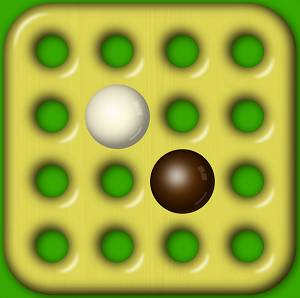 |
Sphex (2011)
Nestorgames version
BGG Entry
|
In collaboration with Cameron Browne.
This simple connection game is part of the Shibumi project; the name Sphex is derived from Square Pyramidal Hex.
|
 |
Spoing (2011)
Nestorgames version
BGG Entry
|
This is a game I designed for Cameron Browne's Shibumi project. It has the dubious distinction of not requiring any stacking :). |
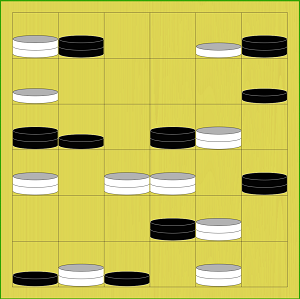 |
Accretion/Rapid Cooling
Play in Ai Ai
|
A set of linked games where the pieces get progressively unwieldy until no more moves are possible. Playable, but a bit dull. |
The following are unfinished experiments, mediocre, or just plain bad. A lot were created for competitions in the BGG forums. One or two may damage your sanity. Play at your own risk!
| Image |
About |
Notes |
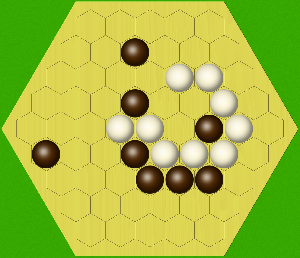 |
Chains (2018)
Play in Ai Ai
|
A chain is a non-branched collection of pieces; make a chain of length N to win.
I can't tell if there is much of a game here or not - there are certainly some tactics around the edge of the board that allow you to kill a chain, but it's hard to stop the first player from continually extending their line to a win. The AI is really bad, though, so it's hard to be sure of anything without seeing strong human play.
|
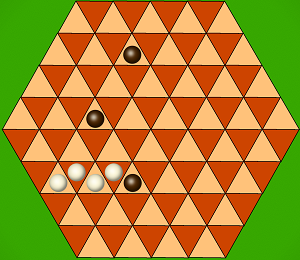 |
Triangline 4 (2018)
Play in Ai Ai
|
I wonderd why no one ever made games on triangle boards. Now I know. |
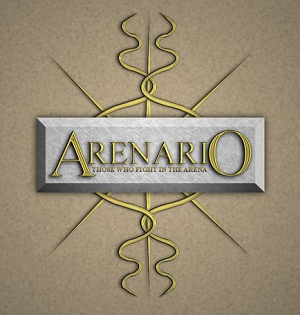 |
Arenario (2009)
BGG Entry
|
Created for a competition, it's a rummy variant with a theme of gladiatorial combat. |
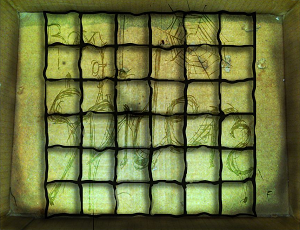 |
Box of Spiders (2009)
BGG Entry
|
This game eventually turned into Web of Flies, which is much better.
Box of Spiders came 4th in this Traditional Card Games Design Contest over on BoardGameGeek (Time Gradient came first).
|
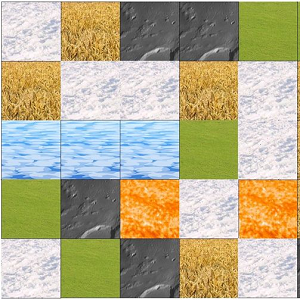 |
Colour Race (2009)
BGG Entry
|
Another competition entry. Interesting mechanism, but too hard to visualise the movement. |
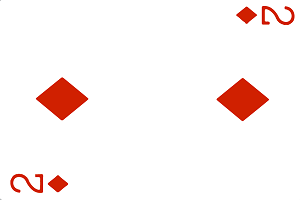 |
Construction Whist (2009)
BGG Entry
|
Competition game (card game). I don't even remember designing this one! |
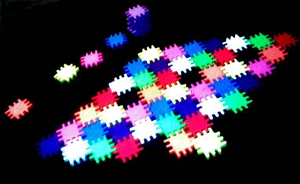 |
Cuboid (2010)
BGG Entry
|
Designed for nestortiles. |
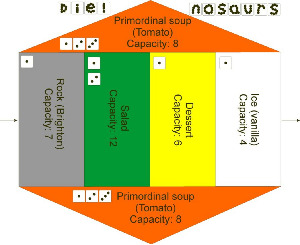 |
Die!nosaurs (2010)
BGG Entry
|
Competition game (dice based). |
 |
Leave Nothing Behind (2009)
BGG Entry
|
Competition game (card based). |
 |
Pangolin Pandemonium (2009)
BGG Entry
|
Competition game (card game). Card game involving pangolins rolling up and down hills. There may be an interesting eurogame in there somewhere, but this wasn't it! |
 |
Zombie Death Suns Ate My Planet (2009)
BGG Entry
|
Competition game (dice). Beautiful plumage, but the parrot is dead. |



























































